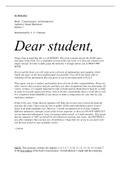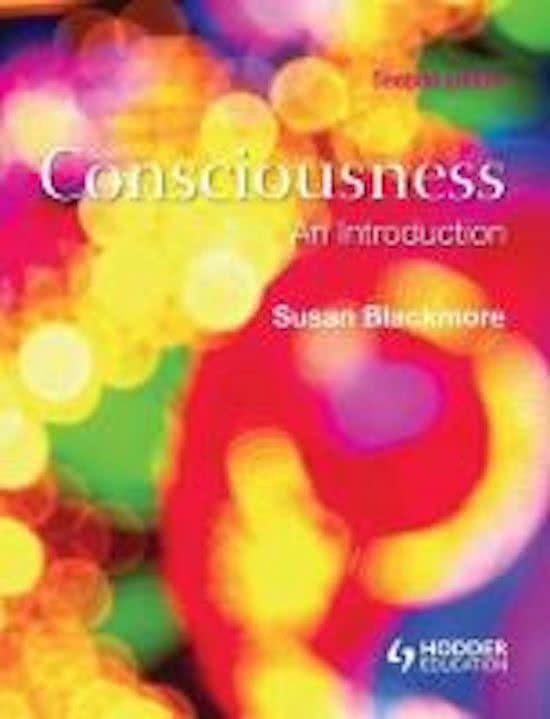SUMMARY
Book: ‘Consciousness: An Introduction’
Author(s): Susan Blackmore
Edition: 1
Summarized by: L. C. Claassen
Dear student,
Please keep in mind that this is a SUMMARY. This work contains merely the MAIN topics
and ideas of the book. It is a simplified version of the real work, so it does not contain every
single concept. In order to fully grasp the material, I strongly advise you to READ THE
BOOK.
If you read the book, you will come across all sorts of explanations and examples which
clarify the topics in the most sophisticated way possible. You will be far better able to
remember all the information that was given to you if you understand it FULLY.
Then again, you are a student, and students have all sorts of other responsibilities. There are
other courses that you must study for and there are other assignments that you must make. Of
course, at times, it is equally important to take a break and not think about school for a while
in order to rest and regain your focus. Next to all this, you probably have a social life as well.
It is completely understandable if you choose to make a compromise for your time by only
studying a summary.
If that is the case, I hope that my summary will help you on your way to learn the material
and pass the exam. I have tried my best to gather all the main information and to write it
down in an understandable way. However, I would recommend you to at least compare
different summaries, and take a look at the lecture material, so that you DO NOT MISS OUT
on any important information. I am a learning student myself, so I make mistakes. This means
that my summary is NOT an end-all be-all solution for passing your exam. And NEITHER is
any other summary that you may use. Nevertheless, I hope that it is of use to you and I wish
you the best of luck in your academic career.
- Lauran
NOTE: This summary contains the chapters 2, 4, 5, 6, 7, 9, 10, 11, 12, 13, 14, 15, 16 and 17
of the first edition of the book Consciousness: An Introduction. I might add the remaining
,chapters in the future. The chapters discussed in this summary are complete and do not miss
any information (even though the course permits you to skip certain parts from the book).
CHAPTER 2: WHAT IS IT LIKE TO BE…?
- The hard problem: we do not have the answer to the question how the experience of
consciousness comes into existence.
What is it like to be a bat?
- American philosopher Thomas Nagel asked one of the most famous questions in the history
of consciousness studies: ‘What is it like to be a bat?’ Nagel wanted to know what it is like to
be another organism; what the experience is like.
- Bats use echolocation; they ‘see’ by emitting soundwaves that bounce off objects and in
turn are perceived by the bat. Because the senses of bats are way different from those of
humans, their perceptual world is also constructed in a whole different way. The experience
of a certain creature (what it is like to be that creature) is called phenomenal consciousness.
Qualia
- Qualia (singular form: quale): private qualities of experiences; what something subjectively
feels like to someone. Conscious experience consists of qualia. Some philosophers, however,
argue that qualia do not exist.
- Since we cannot measure qualia as they are not something physical, deciding whether they
exist comes down to thought experiments: experiments done in the head. They are usually
impossible to carry out.
Mary the color scientist
- One thought experiment is that of Mary the color scientist. Mary is a scientist who is
specialized in color and the perception of it. She knows every possible thing there is to know
about the subject. However, she has been living in a black and white room for all her life and
has never seen any color. The question is: what will happen if Mary is one day left out of the
room to experience color? Will she gain a new experience, or will she be able to point out
every color as if it was nothing new?
- Philosopher Frank Jackson argues that Mary learns something new: she learns what it is
like to experience colors; she now has ‘color qualia’. Philosopher Daniel Dennett claims that
it is not a good thought experiment because we are led to misunderstand it. If Mary would
know everything there is to know about colors, she would already know exactly what kind of
impressions certain colors make on the nervous system. Therefore, she would not be surprised
when she saw them.
The philosopher’s zombie
- The philosopher’s zombie is a person that acts exactly like other humans do and cannot be
distinguished from them but has no consciousness. The zombie has no qualia; there is nothing
it is like to be this person.
, - Philosophers John Searle and David Chalmers both think that the existence of zombies is
possible. The concept of zombies follows the idea that consciousness is an ‘extra option’. This
idea is called conscious inessentialism.
- Philosopher Todd Moody argues against the principle of conscious inessentialism. He states
that, if zombies would exist and live together in a culture on a ‘zombie earth’, they would
have no concepts of conscious states, qualia’s, or dreams or anything else related to
consciousness. Therefore, consciousness is not inessential; it makes a difference. However,
some argue that Moody has broken the rules of the thought experiment, because it was stated
that zombies are indistinguishable from humans.
- Dennett thinks that the zombie thought experiment is nonsense. He comes up with the
concept of a ‘zimbo’: a zombie that is unconscious but can monitor its own internal states
through a reflective method. The zimbo could therefore unconsciously believe that it
experienced certain mental states, so it becomes able to speak about them; it would think it is
conscious. Dennett follows with his famous claim that we are all zombies. What he means is
that consciousness is not separable from our experiences and behavior.
Four types of responses to the hard problem
1. The hard problem cannot be solved; we might simply not have the cognitive capacity in
order to solve it.
2. The hard problem can be solved with drastic measures; we need new fundamental
understandings and theories of the universe in order to understand the hard problem.
3. Solve the easy problems; we will get closer to understanding the hard problem as we get
more answers to easy, scientifically solvable problems.
4. There is no hard problem; because new solutions to easy problems emerge all the time, our
understandings of the world continually change. So, we basically cannot understand the hard
problem right now, and should neglect it. Another theory is that the hard problem is no hard
problem at all, and that we mistakenly divide problems into ‘easy’ and ‘hard’ categories.






